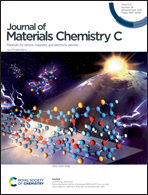Highly efficient and thermally robust cyan-green phosphor-in-glass films for high-brightness laser lighting†
Abstract
Laser-driven white lighting has drawn great attention due to its high-brightness, high efficiency and compact size. However, the current laser lighting usually suffers from a low color rendering (Ra ∼ 60) due to the presence of a wide “Cyan cavity” (460–530 nm) in the luminescence spectrum. Herein, we report on the preparation and characterization of a novel cyan-green color converter, namely Ca3Sc2Si3O12:Ce3+,Na+ phosphor-in-glass (CSS-PiG) film. The addition of Na+ as a charge compensator greatly improved the internal quantum efficiency (IQE) of CSS:Ce3+ phosphors. Because of the good chemical stability and the matching refractive index between the glass matrix and embedded phosphors, the as-prepared CSS-PiG film exhibits an efficient cyan-green emission (with a peak at 508 nm and IQE ∼91%) and excellent thermal stability (maintaining 75% of the room-temperature emission intensity at 300 °C). Under the excitation of a 14.5 W mm−2 blue laser, the PiG film could produce a high-brightness white light with a forward luminous flux of 701 lm, a forward luminous efficacy of 112 lm W−1 and a Ra of 61. By coating a red-emitting CaAlSiN3:Eu2+ layer on the CSS-PiG film, the composite CSS-PiG/CaAlSiN3 film shows an ultra-broadband emission with a full-width at half maximum (FWHM) of 196 nm, which remarkably narrows the “Cyan cavity” and thus provides a Ra above 90. These results demonstrate that the CSS-PiG film is a promising candidate for laser lighting.



 Please wait while we load your content...
Please wait while we load your content...